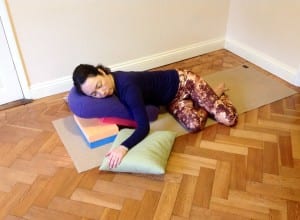Spring is a time of new beginnings, growth and reaching out. It’s time to come out of the comfy hibernation of winter, step confidently into action and create.
In yoga, many of us now feel naturally drawn to more expansive poses, new possibilities and energising breathing techniques that sharpen the mind.
Spring also embodies some significant opposites – a transition from darkness to light, receptive to active, moon to sun and internal to external. The Bhagavad Gita says that ‘yoga is skill in action‘, and this transition requires skilful navigation to honour the season’s energy, be in tune with it in our practice and enjoy its benefits.
According to Ayurveda, Spring carries with her some of the kapha energy of Winter. Kapha governs the structure, tissues and fluids of the body. It protects us, but can lead to lethargy, congestion, stubbornness or resistance when excessive. The presence of vata can also be felt, especially here in windy England. Excess vata can leave us feeling scattered and distracted.
With this in mind, here are three tips to make the most of your yoga and wellbeing this Spring:
1. Spring clean from the inside, while supporting your organs and glands
Stimulate lymph flow and counter congestion as you energise the body and mind with surya namaskar (sun salutations) and dynamic standing sequences including warrior poses and standing balances.
Gently ‘massage’ (compress) and create space for the abdominal organs and wake up the digestive system with twists and forward bends (standing, seated, reclining or inverted). These poses help to remove sluggishness from the liver, gallbladder and pancreas.
Backbends (locust, bridge or full wheel) energise the abdominal organs, lungs and thyroid. These poses open the front body and our manipura chakra. This solar plexus subtle energy centre represents our personal power and vitality. We are ready to be active in the world with purpose.
Going upside down (shoulderstand, headstand, legs-up-the-wall) benefits our organs, glands and health in the head, neck, throat and chest: the thyroid and parathyroid glands, the respiratory system (for relief from congestion and breathlessness) and the nervous system (easing nervousness, irritation and insomnia). The change in gravity creates supportive space for the abdominal organs and for the process of elimination to function effectively.
Spring can be a fun time to reach out and name a challenge – a pose or family of poses you want to focus on, exploring a new intention that emerges, or making meditation part of your day, even by taking 20 mindful steps each morning, akin to walking meditation. What is important, is to approach challenges with the mind and heart focused on the feeling of the process or action, and the outcome then takes care of itself.
If a dynamic practice is not appropriate for you, a restorative practice brings the same benefits, in the form of fully supported floor-based poses. Here are examples of a restorative twist and backbend:
2. Start your day right with energising, cleansing breathing
Kapalabhati (often known as the ‘skull-cleansing’ breath) with its long, steady inhalation and shorter, dynamic exhalations is a wonderful morning wake-up call. I like to practice it first thing in the morning, before breakfast. This is a technique to learn with a teacher, and is not to be practised during menstruation or pregnancy.
If you prefer something less dynamic, the simple, equal breathing rhythm of sama vritti pranayama (for example inhaling and exhaling smoothly through the nose for a count of four) grounds and regulates energy.
3. Remain grounded and practice self-care
Continue with the practices and daily routines that ground and nurture you in order to nurture steady, strong growth. Take care of yourself. Eat well, sleep well.
Always make time for savasana (corpse or relaxation pose/constructive rest), yoga nidra or quiet sitting to allow the organs, glands and body’s systems to function optimally. This meditative non-doing enables us to maintain balance amid the season’s opposites and to re-charge on a regular basis. It provides clarity of mind and intuitive insight, and immense benefits for the health of the nervous system.
Keep your roots and lower chakras firmly connected to the earth to allow your full Spring potential to blossom.
Enjoy your exploration and have a wonderful season.
Photos: author’s own
You might also like:
Yoga nidra for deep rest and relaxation
Morning yoga sequence for energy and optimism
Soothing yoga nidra for sleep
Expand prana with viloma breathing (pranayama)

